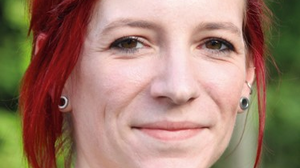Funded researchers: Dr. Jan Clausmeyer, Dr. Lara Schlaffke & Dr. Jan Terhag
Dr. Jan Clausmeyer
Chemistry and Biochemistry

Nanoparticles, tiny assemblies of metal atoms, find application as catalysts in many chemical syntheses and energy conversion processes. Their ability to accelerate chemical reactions depends crucially on their nanostructure, i.e. the arrangement of different atoms to form a particle of a certain size, shape and composition. Simultaneously, carbon dioxide activation is a highly sought-after process which captures the greenhouse gas carbon dioxide and converts it into useful fuels and precious raw materials but yet requires more efficient and well understood catalysts.
When trying to elucidate the intricate effects of size, composition and structure of nanoparticles on their catalytic activity, researchers classically look at statistical ensembles consisting of large numbers of particles. However, individual particles may not be identical but show slight variations in their structure. It is this heterogeneity in the particle population that complicates the identification and characterization of the structural factors dictating the special chemical properties and catalytic activity of nanomaterials.
My project is dedicated to understanding the relationship between structure and activity of nanoparticles by studying single particles instead of statistical ensembles. The Gateway Fellowship allows me to work with Prof. Richard M. Crooks at the University of Texas at Austin, whose group has explored the synthesis, characterization and catalysis of highly defined metal nanoparticles over many years. Applying various complementary analytical approaches, most importantly the use of nanoelectrodes will allow to look at individual nanoparticles, one at a time. The gained knowledge on how size, shape and composition affect chemical activity - in particular for the activation of carbon dioxide - is expected to allow more rational design of highly efficient catalysts in the future.
Dr. Lara Schlaffke
Medicine

The incidence of neuromuscular diseases is about 1 in 2000 but there are more than 800 variants, some of them are rare. The clinical evaluation is mostly based on different methods of which most of them are complimentary. Muscle exercise testing for example is non-invasive, easily applicable, and repeatable. However, it is somewhat imprecise for subtle muscle changes and to some extent also dependent on the rater. Genetic evaluation and histopathology on the other hand are very precise, however expensive and invasive.
Muscle imaging, with its various techniques allows on one hand for qualitative assessment, but also with the usage of novel techniques for quantitative assessment. Conventional T1-weighted images for example allow the evaluation of various patterns of affected muscles and relative fatty degeneration of single muscles and give evidences for different disease types and could therefore be useful for initial diagnosis. Using diffusion weighted imaging and tractography in the muscle, gives valuable information about muscle structure and architecture but also semiquantitative measures of muscle integrity. Phosphor spectroscopy is a method, which with metabolite concentrations and ratios of free phosphate and ATP can be quantified. It has been shown to be able to detect changes in such phosphor ratios even prior to the detection of fatty infiltrations. T2-mapping serves as a biomarker for inflammatory processes. It is very sensitive to even subtle changes in the muscle prior to severe oedma. mDixon is a very fast imaging technique, which allows not only the detection of fatty degeneration, but also the exact quantification of water / fat percentage.
My Gateway Fellowship aims to combine these methods in a clinically feasible MR- scanning protocol and to validate acquired data in a multicenter approach. Together with my research collaborators in Utrecht and Leiden, I will learn the different methods of quantitative muscle imaging and apply the developed scanning protocol in the leg muscles of a healthy population in 3 centers (Utrecht, Leiden and Bochum), to which patient data can then be compared. The Fellowship will allow me to be integrated into an innovative research network between the UMC in Utrecht and the Gorter Center in Leiden and will offer the possibilities to expand the scope of the project and extend the collaboration through longer term funding opportunities.
Dr. Jan Terhag
Chemistry and Biochemistry

Epilepsy in Infants with Migratory Focal Seizures (EIMFS) is a very rare but grave form of epilepsy. It affects newborns and is characterized by extremely severe seizures. 20 % of children with the disease die before the age of four; the majority of those who survive suffer from developmental arrest and remain at the level of a young child for the rest of their life. One of the defining features of the disease is that the seizures start in a confined region of the brain and then migrate to other regions; the reason for this is not yet understood.
Ion channels are proteins that allow electrically charged particles (ions) to pass the membrane of cells – neurons, for example - and elicit changes in the cell’s electric potential. They are the molecular basis for the electric signals that comprise the brain’s activity. Malfunctioning ion channels can have serious consequences for the function of the brain.
Recently, a certain ion channel, the sodium-activated potassium channel KCNT1, has been found to be malfunctioning in over 50 % of children with EIMFS. The Ion Channels & Disease Group of Prof. Steven Petrou at the Florey Institute ôf Neuroscience and Mental Health in Melbourne, Australia, currently tries to find out how exactly this malfunction causes the specific symptoms of EIMFS and how they could be combatted.
In my project, I will use state-of-the-art imaging methods to understand the root cause of EIMFS and how seizures migrate through the brain. During my gateway fellowship, I will set up a two-photon fluorescence microscope that I will use to monitor neuronal activity in mice that have mutations in KCNT1 and show EIMFS-like symptoms. Additionally, I will use electrophysiological methods to pinpoint the brain regions which are crucial for the emergence of seizures in EIMFS.
- Forschungsbezogene Kompetenzen: Workshops & Veranstaltungen
- Karrierevorbereitung: Workshops & Veranstaltungen
- Forschungsmanagement Skills: Workshops & Veranstaltungen
- Liste aller Workshops & Veranstaltungen
- Förderprogramme zur Internationalisierung
- Beratung & Ombudsperson
- Promovierenden-Datenbank
- Welcome Hour
- Newsletter


